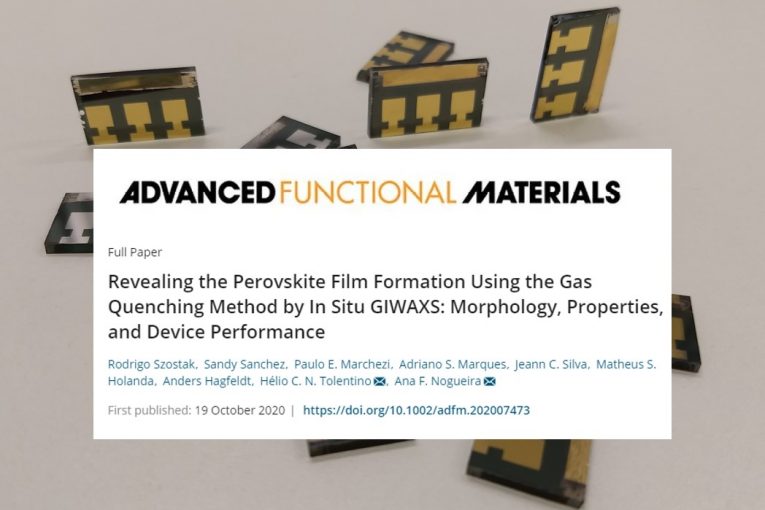CINE research monitored, in real time, the formation of perovskites for solar cells.

Many of us know that perovskite solar cells have become competitive in efficiency terms in just a decade. Perhaps less know is the fact that these solar cells can be stacked above silicon solar cells, forming a junction of devices called “tandem”, with even greater efficiency than that of each of the parts. However, these good results generally correspond to small devices, used for laboratory research. This, succeeding in producing large areas of perovskites without impairing efficiency is an important challenge.
In an interesting experiment performed in the Brazilian National Synchrotron Light Laboratory (LNLS), CINE researchers and collaborators monitored, step by step, how the formation of perovskites by the gas quenching method occurs. That process had not been studied in detailed before, in spite of enabling the production of films of large areas. To obtain perovskites using this method, the first step is depositing, on a support, a solution containing the perovskite precursor compounds. When the solvent evaporates, the material crystalizes and forms the organized structure of atoms proper to the perovskites. However, before this happens, several compounds with different structures (the so-called intermediaries) are formed momentarily.
In the experiment carried out at LNLS, the scientific team analyzed each of the intermediaries, using a technique of characterization by X rays which provides information on the crystalline structure of the materials. In the preparation of the initial solutions, the team used two different solvents combined with several precursors and noted that each combination leads to a single path of intermediaries formation, which impacts the morphology and final properties of perovskite, and, therefore, in their efficiency in the solar cells.
“In this paper, we used the GIWAXS technique to monitor in situ the evolution of the perovskite intermediaries during their preparation by spin coating with the gas quenching method. The results showed that the solvent that is used (NMP or DMSO) directly influences the intermediaries that formed, as well as the composition of the perovskite”, says Rodrigo Szostak, who developed this research within his doctorate, within the CINE’s Dense Energy Carriers Division.
“This paper helps researchers who work with tandem because it allows them to choose the best composition/solvent combination to adjust the solar cells which goes on top”, completes professor Ana Flávia Nogueira (UNICAMP), principal investigator at CINE, who coordinated the paper with the LNLS researcher Hélio Tolentino. Other members of the group of professor Ana Flávia at UNICAMP and collaborators of EPFL (Switzerland) also took part in the research.
The article which reports on this research was published in October in the scientific magazine Advanced Functional Materials (impact factor = 16.836).
Paper: Revealing the Perovskite Film Formation Using the Gas Quenching Method by In Situ GIWAXS: Morphology, Properties, and Device Performance. Rodrigo Szostak, Sandy Sanchez, Paulo E. Marchezi, Adriano S. Marques, Jeann C. Silva, Matheus S. Holanda, Anders Hagfeldt, Hélio C. N. Tolentino, and Ana F. Nogueira. Adv. Funct. Mater. 2020, 200747. DOI: 10.1002/adfm.202007473











